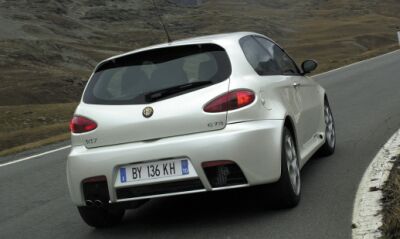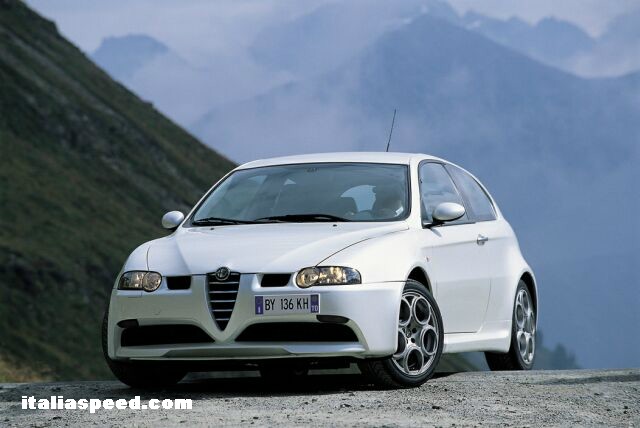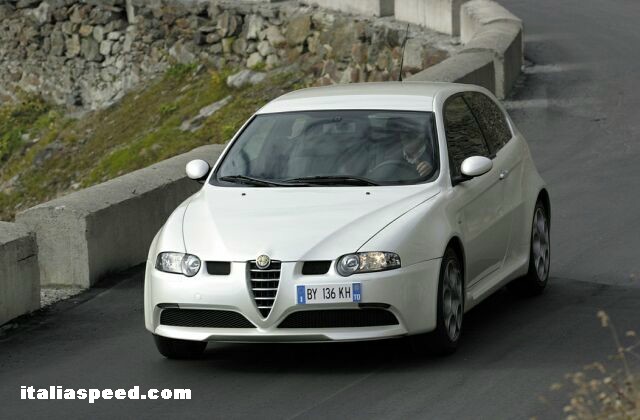| >>> suspension
The Alfa 147 GTA suspension
layout is based on a combination of high double wishbones at the front
( the only car in its segment to offer this configuration ) and an advanced
MacPherson arrangement at the rear. This engineering option has already
brought the Alfa 147 great success and has been specially adapted to the
upgraded features of the new car to assure the Alfa 147 GTA outstanding
dynamic performance coupled with superlative comfort.
The suspension is the final
outcome of a long and thorough development process carried out on the basic
layout with the aim of achieving the highest levels of driveability and
handling. These features allow the person behind the wheel maximum mastery
of the new car's great sports performance for the best possible results
on the road. From the customer's viewpoint, the new version:
- is responsive;
- is smooth and accurate
in its steering;
- is very stable and easy
to control even when close to the grip limit;
- features highly contained
body movements;
- and offers great comfort
in all service and road surface conditions.
front suspension
The Alfa 147 GTA offers its
drivers the great control typical of front wheel drive cars plus outstanding
sportiness and driving precision. This is particularly evident over mixed
routes. The credit for this goes first and foremost to the high double
wishbone front suspension. The new front suspension was developed specifically
for the model by the Fiat Research Centre and Alfa Romeo Research. It departs
from the configuration used on the Alfa 147 in offering a reinforced lower
beam, lower ride, new shock absorber and spring settings, a special wheel
strut that is fastened to the steering link in a different position - and
a larger diameter stabiliser bar.
These engineering improvements
increase the dynamic performance of the high double wishbone suspension
- known as a quadrilateral suspension because the arms ( two overlapping
triangles with their bases hinged to the car body and their tips to the
wheel unit ) create a four-sided figure.
The device structure consists
of a cast iron lower arm, a steel strut and an upper light alloy arm. The
coaxial spring-shock absorber unit is connected to the body via a flexible
mount and to the lower arm via a light alloy fork. For reasons of space
and structural stiffness, the upper arm is jointed to an aluminium shell
( anchored to the body ) which acts as a support to the upper spring-shock
absorber attachment. From a dynamic viewpoint, the high double wishbone
layout ideally combines broad wheel travel with outstanding control of
tyre service conditions. This is achieved because the upper arm is located
higher than the wheel centre: this means that the area between wheel and
power unit accessories can be exploited to the full. And more. Other benefits
of this configuration include excellent tyre grip, improved traction even
under extreme conditions, a self-alignment effect proportional to the side
acceleration applied on a bend, greater steering precision and sensitivity,
gradual and even steering wheel effort to the grip limit - and also cancelling
of lift (lifting of the front during acceleration ) and antidive effect
( dipping of the front end when braking ).
Great attention has also
been devoted to the absorption of minor roughness. Hence the choice of
fluid dynamic bushes to hinge the upper triangle to the shell; split gaskets
and bushes in Teflon loaded with fibreglass for the shock absorber stems
- plus a Teflon seal for the shock absorber piston.
rear suspension
The rear suspension has also
undergone many technical improvements. The geometry and the constructional
details of the tried and tested MacPherson configuration have both been
revised. The outcome is a different body attachment position; special spring
setting; different shock absorber and bush stiffness; antiroll bar with
bigger diameter.
The GTA's MacPherson suspension
also adopts innovative construction features. For example, the coil springs
not only offer a different stiffness and lower ride to those of the Alfa
147 but also rest on a lower and upper plate with an interposed rubber
ring to reduce noise levels. And a stabiliser bar ( connected directly
to the shock absorber via plastic connecting rods and jointed on steel
ball joints ) with a Cellasto upper end travel block ( closed cell polyurethane
that maintains its flexible properties over time ). The double-acting hydraulic
shock-absorbers, also new, are pressurised and built in high strength steel
with reduced thickness. Lastly, the side levers, suspension arm and rear
beam bushes are all made especially for the Alfa 147 GTA. The upper shock
absorber attachment also displays a new tapered block fastening system.
Assembly is easier and the system is more reliable because the attachment
need not be bolted to the body.
These significant technical
innovations and features are bound to improve performance and driving comfort
still further. Suffice it to say that the modified rear suspension can
absorb obstacles more easily because the wheels withdraw lengthways to
keep the car on its trajectory. The system also assures maximum directional
stability when the car meets obstacles such as tram lines, dilation joints
on motorway bridges. And more. The Alfa 147 GTA rear suspension increases
the smoothness and alacrity of steering response and means the car is more
able to align itself automatically, even under extreme conditions. This
is achieved by ensuring the wheel steers consistently under side load.
Not to mention the fact that the Alfa 147 GTA gains negative wheel camber
during roll due to the new rear suspension. In other words, cornering grip
is increased to ensure the roll centre position is more accurate to improve
the car's general balance. |



